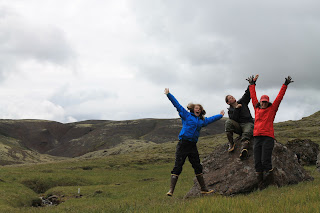 |
| We found algae! |
This summer we are planning to measure nitrogen fixation with three different approaches as a comparison of the methods, as well as to use them as a check against each other. For
 |
| Chemical conversion of nitrogen fixation (left) and how it compares to acetylene reduction (right). |
 |
| Working on getting "the" number. |
So far, our research has been really frustrating, impossibly complicated, and infinitely
 |
| Excited after a day in the field of hiking and looking at algae. |
coolness! Question. . . you 'trick' the N-fixers into reducing acetylene instead of N2, but why are they tricked? Presumably they have a choice to fix N or 'tweak' acetylene. Why do they tweak acetylene?
ReplyDeleteWyatt
Well, the nitrogen fixers contain the enzyme nitrogenase, which is capable of breaking down both nitrogen gas and reducing acetylene into ethylene. It just so happens that acetylene inhibits nitrogen fixation, by having a higher affinity for the binding site on the enzyme than the nitrogen gas molecules. Nitrogen fixation is also energetically expensive and requires three times the amount of energy to break the triple bond in nitrogen gas than it does to break the triple bond in acetylene gas, because the nitrogen molecules bond together stronger than the carbon molecules of acetylene. It is not that the enzyme is not fixing nitrogen, but they are fixing more acetylene, so we use a theoretical ratio that says for every 3 moles of acetylene that are reduced, 1 mole of nitrogen gas is fixed (Stewart et al. 1967, Hardy et al. 1968), so we can use this ratio to correct for our final nitrogen fixation rates. Since this ratio is theoretical and based on chemical properties of the molecules, it is not always what is seen in real measurements of nitrogen fixation. Literature has shown ratios of acetylene reduced to nitrogen fixed to be anywhere from as low as 0.0216:1 (Liengen 1999) to as high as 94:1 (Seitzinger and Garber 1987). Because there has been such variation in these ratios, and discussion about what the right ratio is, we are interested in measuring what these ratios are for the Hengill watershed in Iceland, because they can really vary from site to site.
ReplyDelete